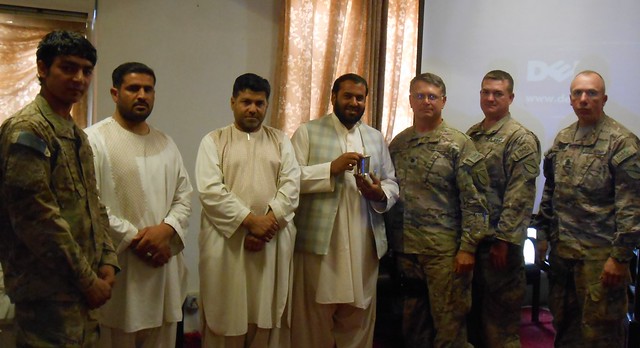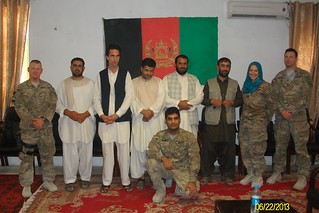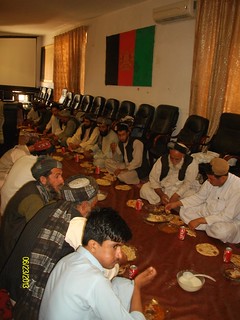Story and photos by Staff Sgt. Sidney Hoffmann, ADT 5 Unit Public Affairs Historian Representative
[caption id="" align="aligncenter" width="576"]

Lt. Col. Dallas Kratzer, Maj. Bill Hatfield and Sgt. Maj. David Munden meet with District Education Representative Bismillah Khan (center) and fellow Kandahar University staff members. Kentucky Agribusiness Development Team 5 took an educational approach to an agricultural problem and found great enthusiasm and success. (U.S. Army National Guard photo by Staff Sgt. Sidney Hoffmann)
ZHARI DISTRICT, KANDAHAR PROVINCE, Afghanistan -- Before Kentucky Agribusiness Development Team 5 left the U.S. for its service in Afghanistan, it was their desire to bring agricultural leadership education to Afghanistan. The Soldiers and Airmen all held a strong belief that the future of Afghanistan lay in the hearts of young men and women who were open to learning new agricultural information, skills, techniques, and leadership abilities to equip them for a new Afghanistan that could stand on its own and serve its people.
"The key to Afghanistan’s success is the education of its young people, especially as it relates to agriculture," said Col. Bob Hayter, the team's commander. "Approximately 80% of Afghanistan’s economy is based on agriculture.”
Lt. Col. Dallas Kratzer agreed, adding that, “Much of the agriculture success in the US has its roots from organizations like 4H and FFA. It’s time to help partner, encourage and foster a Future Farmers of Afghanistan.”
[caption id="" align="alignleft" width="320"]

Tech. Sgt. Nathan Steele, Capt. Lund, 1st Lt. Benjamin Maillet worked with the Assistant District Governor of Zhari and Kandahar University Professors to educate local citizens on a wide variety of agricultural practices. (U.S. Army National Guard photo by Staff Sgt. Sidney Hoffmann)
Youth Leadership organizations like FFA and 4H have had a huge impact on American Agriculture. In many ways these organizations have shaped the American culture in entrepreneurship and leadership to where we are today. With 4H celebrating its 100 year anniversary and FFA celebrating it 75 year anniversary this past year, it is no wonder the United States has come so far with these combined years of investment leading to the agriculture leadership and ingenuity across our great country.
The first task was to identify a program that had an Afghan look and feel to it, being easily accepted by the Afghan culture and community. Curriculum promoted by KY ADT 3, written in Pashto, and supported by the Ministry of Agriculture at the capital in Kabul were found, along with several boxes of books, patches, and pins that students could earn while moving through the program.
The program selected was built on four important pillars; learning, doing, earning, and serving. Team members found this to be very profound as it is modeled programs like 4H back home, focusing on using the head, hands, heart, and health.
“This principle of ‘earning’ is important," said Tech. Sgt. Nathan Steele who, along with 1
st Lt. Benjamin Maillet, made up ADT 5's Team Zhari. "After decades of war, a lot of Afghans have a difficult time looking at agriculture as a means to generate income, as a lot of families are simply using their farms to sustain them. Until recently, the district was too dangerous to travel to conduct business transactions, so most families produced only what they needed, not necessarily what they could sell for profit at the local market.”
[caption id="" align="alignright" width="240"]

High school and middle school teachers attend a course given by the Kandahar University Professors in the Zhari District, Kandahar Province, Afghanistan. The teachers' instruction was facilitated by 1st Lt. Benjamin Maillet and Tech Sgt. Nathan Steele of Kentucky's ADT 5. (U.S. Army National Guard photo by Staff Sgt. Sidney Hoffmann)
With a solid foundation of an Afghan Youth Agriculture FFA style program already in existence, the Kentucky Guardsmen did not have to reinvent the wheel; they just had to find an avenue to implement this program successfully in Zhari. Although the program was intended to work through the District Director of Agriculture Irrigation and Livestock, the team took a different approach, building a relationship with the Director of Education Dr. Bizmillah Kahn. Together they started a Youth Agricultural Program in his district, as an after school program to over 500 students in two high schools and one middle school, teaching both boys and girls, eventually expanding it to all 5,000 students.
The curriculum was printed as a 70 plus page book in color giving teachers the ability to teach students about water management, irrigation techniques, soil management, wheat & corn production, chicken and egg production, terracing and rice production, and the water cycle that could have immediate impacts when students take this information back home to their families, having a lasting impact on their future.
Most important, the program was about Afghans teaching Afghans teaching Afghans! Kandahar University professors were going to teach high school teachers, who were going to teach students in their classrooms. Furthermore, according to Dr Bismillah Kahn, those high school teachers who received training were going to train other teachers to teach this program in their classrooms.
The Youth Agricultural Training was a huge success. It was supported by and attended by the district governor and the assistant district governor of Zhari, who encouraged them to teach this program well in their schools so the students could take these skills home with them to help their families, that this would bring honor for them.
[caption id="" align="alignleft" width="320"]

Tech. Sgt. Nathan Steele hands school supplies over to District Education Representative Bismillah Khan. The supplies were donated by Luhr Elementary School and Midway College in Kentucky. (U.S. Army National Guard photo by Staff Sgt. Sidney Hoffmann)
Along with this program KY ADT 5 delivered school supplies donated from Luhr Elementary School and Midway College in Kentucky to Dr. Bismillah Kahn to give out in his schools. This further created momentum for this program as they now had supplies to work with while making a friendly link between the students and teachers from the US, to those in Afghanistan.
Team Zhari’s outside the box thinking was instrumental to the program’s success. They had done two things never done before; moving the program through the Director of Education and creating a 70 plus page curriculum in color for the Youth Agricultural Program to meet the specific needs of the district.
“It was the right call to move this program through the Director of Education Dr. Bismillah Kahn," said Maillet. "In Afghanistan, having the right program is not enough. You have to put it into the hands of the right people if you want to see it to succeed.”
“This Youth Agricultural Program is the most sustainable thing KY ADT 5 has done and has the potential to last years after we are long gone," said Steele. “We just put valuable agricultural information into the hands of Afghans they put together themselves, through a program they are excited about expanding themselves.”
“My grandfather always told me hast makes waste," added Steele. "This time we didn’t care more about this program than the Afghans did, we moved slowly and carefully, they took ownership of it and are carrying it forward. I guess he was right.”
“The way you change a culture is to engage and inspire the youth," said Kratzer. "A program like this has the ability to effect change a generation from now. What these students will learn can never be taken away from them.”
Future success of this Youth Agricultural Program and impact on the Province of Kandahar is yet to be seen, but based on programs in the United States, its effect could be far reaching and last for years to come.
“We may never know what far reaching impacts that one idea or program can have," said Hayter. "We have planted a lot of ideas or seeds here in Afghanistan. Who knows what it will look like when these ideas take root and grow into something we could never imagine.”